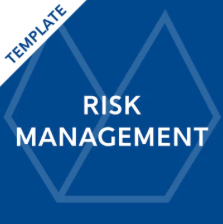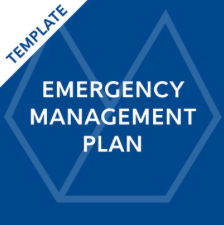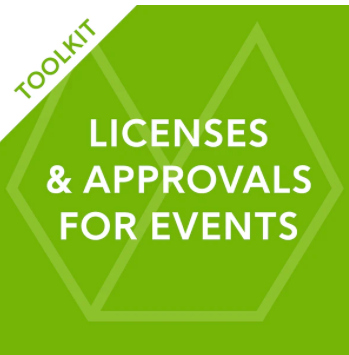Four straightforward steps to managing risk at your event
Some event organisers avoid or postpone risk management planning but emergencies can happen at any event, no matter what size.
Risk is more than the safety of event attendees – what about financial and reputational risks?
Risk management does not have to be intimidating! Simple processes in place will help you sleep at night.
There are four simple steps to risk management
Step 1: Identify risks
Step 2: Evaluate the risks
Step 3: Mitigate the risks
Step 4: Review the effectiveness of your risk management
How to identify risks
Have a simple brainstorming session about all of the potential risks at your event with everyone involved in it. This doesn’t have to be hard - just add the brainstorming session to a meeting agenda.
The main risks to consider are
what could cause injury to an attendee or worker
what could damage equipment, infrastructure or the site/venue
what could harm the future of the event, or the organising committee (e.g. financial and legal risks).
Ask ‘what if’ questions:
What if we lost power?
What if key managers were sick on event day?
What if there was a storm during the event?
What if a major sponsor or grant funding was lost?
Have each of the organisers of each aspects of your event identify the risks for the area they are responsible for.
Now you have a whole list of potential risks for your event.
How to evaluate potential risks
You’ll now work out the likelihood of each risk happening (very likely to unlikely) and the consequences it would have if it did happen (major to minor impacts), and that will determine its level of risk: low (green in the image below), medium (yellow), high (orange), or extreme (red).
For example, a fire may be unlikely, but could have very high impact on your event so it has a high risk level.
Now, go through this evaluation process with each of the risks you identified.
Once you’ve evaluated the level of each risk, you can then understand what the risk management priorities are, and you can figure out what actions to take to mitigate them (reduce their likelihood or reduce their impact if they did happen).
How to mitigate risks
Now your committee will need to decide what steps you will take to reduce and avoid any medium and high risks.
You can manage low risks with your everyday processes.
If you have any extreme risks, you must find ways to completely avoid them. There’s no mitigation (risk reduction) for extreme risks.
The key to risk management is prevention is better than cure (having to deal with a risk taking place).
Contingency plans
How would you respond if something bad happened at your event? Now is the time to plan in advance what you will do if
the weather is wet or adverse
the headline act is a no show
you have way fewer volunteers on the day than you need
the key event coordinator is not available on the day of your event
you lose power
Considering and planning for your medium and high risks means you will still be able to deliver an amazing event experience if you have to also cope with unfortunate circumstances.
Once you’ve done this process once for your event, you then have a framework that can just be reviewed each year, and adjusted if necessary.
Case studies
The day we attended Chinchilla Melon Festival there was a burst water main under the road right beside the festival, cutting off the town’s and the festival’s water supply for hours on a really hot day - and with the key element of the festival being watermelon games that left dozens of participants covered head to toe in sticky watermelon juice.
There were water trucks for participants to use for showering but these ran dry by the end of the day (then the water came back on).
We attended the Peter Allen Festival in Tenterfield while a bushfire lapped at the houses on the edge of the town. Though the festival’s events continued, news of the fire impacted attendance, and a number of the event’s volunteers had to leave to fight the fire or protect their homes.
Often the challenge for event risk management is not about ensuring things don’t happen; it’s about making sure that you can continue to deliver a quality experience for your attendees in a safe environment.
Review your risk management
After your event, arrange for a debriefing session to assess what worked well and what didn’t in terms of risk management. If any risks came up that had to be managed, how well did the team respond to them? What were the learnings for next time?
DIY risk management templates
We’ve got two templates to help you - a risk management plan, and an emergency management plan that outlines what you will do if a risk happens for all staff, volunteers and stakeholders.
Legal liability
What is your committee’s legal liability?
We cannot provide you with legal advice, and if this is something that concerns you, you should seek out legal advice.
Basically, liability comes down to duty of care, which means taking all possible steps to avoid potential injury to everyone involved - which involves going through the due diligence described in the steps above, and enacting mitigation actions.
Insurances
We recommend that you seek advice on which insurances you should have for your event.
Some types you may want to consider include:
Public liability insurance, which covers costs related to accidental injuries to members of the public
Volunteer insurance or workers compensation insurance, which covers costs due to a member of staff or a volunteer getting hurt at the festival
Adverse weather insurance, which will cover your event against cancellation expenses due to adverse weather conditions that makes your event unsafe for people to attend
Cancellation insurance, which covers the costs if your event is cancelled due to any unavoidable reasons not known to you when you took out the policy
Property and equipment insurance, which covers against the loss of or damage to equipment
Vendors, contractors and third-party suppliers must also be adequately covered by insurance, and it’s up to you to confirm they are. Always obtain and keep a copy of their certificates of insurance, and make sure that they name the event as an interested party and additional insured party in their policy. Have a good look at their policy to make sure it includes adequate cover.
Licenses and approvals
Lastly, what licenses and approvals will you need for your event? Consider traffic management, road closures, alcohol and food sales, waste management, noise levels, the safety of temporary structures such as stages or marquees, fireworks, animals, rides and more. Consult with your Council as early as possible to identify which licences, approvals and permits you require.
Learn more in our online training module
In our Operations & Risk Management module, you’ll learn risk management skills via
A training video
Case studies that show how other events do risk management
Q&A for discussion on the topic
Supporting templates that help you action learnings
Lesson 1: Is it really a risk? Defining risks
Lesson 2: Prevention is better than cure. Developing your plan and communicating it!
Lesson 3: Streamlining operations






